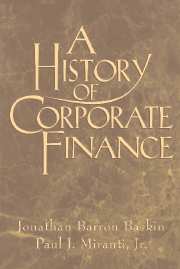Book contents
- Frontmatter
- Contents
- Preface
- Introduction: History and the Modern Theory of Finance
- Part I The Preindustrial World
- Part II The Rise of Modern Industry
- Part III The Transition to the Contemporary Era
- Epilogue
- APPENDIX A Finance and Informational Asymmetries in the Ancient World
- APPENDIX B International Patterns of Corporate Governance
- Index
APPENDIX B - International Patterns of Corporate Governance
Published online by Cambridge University Press: 22 March 2010
- Frontmatter
- Contents
- Preface
- Introduction: History and the Modern Theory of Finance
- Part I The Preindustrial World
- Part II The Rise of Modern Industry
- Part III The Transition to the Contemporary Era
- Epilogue
- APPENDIX A Finance and Informational Asymmetries in the Ancient World
- APPENDIX B International Patterns of Corporate Governance
- Index
Summary
Corporate finance has been influenced by two distinct patterns of governance in the world's leading securities markets. At one end of the spectrum are the similar systems that have emerged in the United States and the United Kingdom and are characterized by freely competitive markets, transparency in corporate affairs and regulatory structure to protect investors from the incompetency or dishonesty of agents. These are quite different from the uninformative, opaque regimes of Japan and Germany, where powerful private and/or governmental institutions dominate local markets through informal, cooperative relationships.
Reliable information strengthens the Anglo-American financial markets, facilitating the pricing of securities and thereby enabling the market to allocate capital efficiently. In addition, it augments economic growth by increasing opportunities for profitable transacting by investors.
Complementary monitoring patterns – one professional and the other governmental – provide assurances in the Anglo-American markets of the reliability and currency of corporate information. The agencies were originally limited to boards of directors, public accountants, attorneys, investment bankers and other professionals whose scope of fiduciary responsibility derived largely from a path-dependent process involving legal precedents. The state later provided a second level of monitoring, which also reinforced the position of professional groups.
In Britain the connection to government was initially defined in various companies acts that mandated filing corporate financial statements with the Board of Trade (now the Department of Industry and Trade). Before 1986, regulation of the share market remained largely in the hands of the Stock Exchange, attorneys, accountants and other professional groups. In a highly homogeneous society like Britain, such an informal system worked relatively well because of a more general willingness of the public to defer to the judgments of respected professionals.
- Type
- Chapter
- Information
- A History of Corporate Finance , pp. 322 - 330Publisher: Cambridge University PressPrint publication year: 1997



